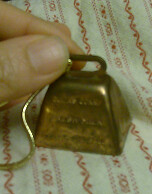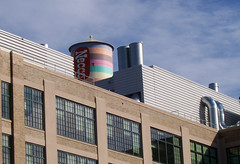Archive for the ‘manufacturing’ Category
Bevin Bell Factory Fire
In December 2010 I posted about the Bevin Brothers bell factory in Connecticut, last of its kind in the United States. Alas the East Hampton, CT factory burned down on Saturday. The factory was built in the 1880s. In the past there were over 30 bell factories in the area, which came to be known as “bell town.” Owner Matt Bevin, descended from the founding brothers, is cautiously optimistic about rebuilding but only if it is cost effective.
American Shoes to China
It’s old news that American shoe manufacturing has moved overseas, mostly to China. One of the few companies still making shoes in the USA wants to tip the balance the other way by marketing its shoes to the Chinese. Allen Edmonds, a privately held manufacturer of men’s shoes in Wisconsin, is opening a store in Shanghai this year. They’re hoping that “Made in the USA” will be as distinctive in China as it has become back home. If the approach succeeds, they have plans to expand into Hong Kong and Macau, but they won’t move production to Asia like so many others have. Allen Edmonds shoes were worn by Presidents Reagan, Clinton, and the Bushes for their inaugurations.
Steuben Glass Closes
Corning Inc. has ably survived into the computer age with its glass a necessity for electronic displays both small and large. In 2008 it shed its money-losing luxury glass division, selling Steuben to Schottenstein Stores, a holding company of various retailers. Steuben is the last manufacturer of luxury lead crystal in the United States. It continued to lose money and in August of this year Schottenstein announced that the 108 year old company will close in November. The flagship Steuben store on Fifth Avenue in New York will close after 77 years of business. Buyers of wedding gifts, commemorative glass pieces, and mementos for heads of state and royalty will have to find something else. The Corning Glass Museum has replaced its Steuben store with works of local glass artists. Steuben’s online store has marked down the merchandise so for some time you can still get an animal hand cooler without having to turn to eBay. Corning has bought back the brand name so perhaps one day when we tire of buying each other gift cards and electronic devices Steuben can shine again.
The Bankruptcies of Eddie Bauer
Retailer Eddie Bauer has been pulling itself back from the brink of bankruptcy, the second in its 90 year history. Seattle Met magazine has a nice article on the history of the company detailing how its latest CEO Neil Fiske has been rebuilding on its outdoorsman heritage. Eddie Bauer began as a sporting goods company with Bauer repairing tennis rackets and patenting a badminton shuttlecock. His love for fishing led to a down-filled jacket which led to a commission for the Army which led to a mail-order business that included women’s clothing created by Bauer’s wife. He sold the company in 1968 to General Mills and went back to fishing. General Mills also owned Talbots and Eddie Bauer’s women’s clothing line grew into a huge success. General Mills cashed out in 1988, selling to Spiegel. Things went well until Spiegel topped under the weight of defaults from the gobs of easy credit it had handed out to eager shoppers. Eddie Bauer survived its parent’s bankrupcy by taking on a huge chunk of Spiegel’s debt. Repaying that debt took its toll on their bottom line. Neil Fiske was brought in as a CEO with vision. Miraculously, second bankruptcy proceedings saw Eddie Bauer through the 2008-2009 downturn. It emerged from bankruptcy auction with the Spiegel debt erased and Neil Fiske still in charge courtesy of investors who believed in the progress he’d made and his passion for the brand’s history. James Whittaker wore an Eddie Bauer parka when he become the first American to climb Mount Everest in 1963. Fiske brought in Whittaker’s nephew Peter to develop the First Ascent line to bring Eddie Bauer back to the mountains. He’s planning to retake the forest and streams too. It’ll be a tough road.
Marimekko Helsinki
The September issue of Dwell takes you behind the scenes at textile company Marimekko. Founded in 1951, the Finnish company’s bold prints received a boost in the U.S. from Jacqueline Kennedy who wore several of their dresses in the 1960 presidential campaign. More recent publicity came from clothing and tablecloth appearances in the TV series “Sex and the City.” Crate & Barrel’s partnership with Marimekko started in the 1960s and their designs are available on pillows, sheets, and other housewares. Their colorful patterns are silkscreened in up to 12 colors. Dwell’s slideshow runs through 13 patterns and the designers and inspiration behind them. The article describes the design and printing process.
Necco to Novartis
It’s been years since the sweet smell of the NECCO factory wafted across Cambridge, but I still missed that sugary air on my recent trip back. The Novartis Institutes for BioMedical Research (NIBR) took over the 1927 factory building after a $120 million transformation completed in 2004. The old candy factory that was sometimes referred to as Willy Wonka’s (I never saw anyone go in or out) now features two pairs of glass elevators like Charlie’s. The inside is completely transformed and the outside has been updated but had to conform to Cambridge’s strict hold over architectural improvements. In 1996, NECCO’s water tower was cleverly painted to resemble a stack of NECCO wafers. Novartis knew the iconic tower had to remain, but with a new identity. They sponsored a competition to solicit ideas from local artists and students. Joseph DePasquale won with a DNA double helix representing the company’s mission. A PowerPoint deck from Sponge Jet chronicles their careful restoration of the rusty tank with consideration for containment of the dust. The redone building may not emit a sweet smell (and considering the research going on inside we probably don’t want it to emit anything), but it retains some essence of the magical concoctions that it used to house.
Cerium Oxide Polish
Glass artists who polish their works to a high shine with cerium oxide are getting hit with a hugh price increase from a shortage of the rare-earth element. China has reduced exports of cerium oxide and prices at one supplier have gone from $10 per pound eight months ago to $66 today. A mine in California that closed in 2002 after it couldn’t survive against the cheap pricing from China has now reopened to help with supply. There are alternative techniques and materials for polishing, but cerium oxide is the fastest. From the environmental perspective, perhaps China does have some good interests behind the shortage as they say the reduction came from tighter controls on the damage caused by mass-extracting rare earths.
The Paper Newspaper: Shrink or Disappear?
Broadsheet newspapers have been decreasing their “web width” from the old standard 54 inches to 48, 46, and as small as 44 inches over the last five or so years. The reduction saved costs, was advertised as easier to handle, and didn’t require new presses. Poynter reports than an even smaller option is available: the “three-around”. Current presses are retrofitted to a system that so that “plate cylinders print three sheets in a single revolution, rather than two”. The result is a paper size that isn’t quite a tabloid, but is significantly smaller than even today’s shrunken broadsheets. The three-around saves newsprint and prints more papers in less time. But the machinery changes are an investment — perhaps better spent on electronic delivery formats?
Bells from Connecticut
 East Hampton, Connecticut was known as “Bell Town, USA” years ago when the town produced 90% of the world’s sleigh bells. The bell companies benefited from a law mandating that all sleighs, which run silent in the snow, use bells to warn pedestrians. With manufacturing shifted overseas, what’s left in East Hampton out of what used to be over 30 bell foundries is the proud sixth generation of the Bevin Brothers who’ve been making bells in Connecticut since 1832. If you’ve heard a Salvation Army bell ringer, you’ve heard a Bevin Brothers hand bell. The product line includes cow bells, mechanical door bells, prize fighter bells, and of course the classic sleigh bells. They say they’re the only company in the U.S. manufacturing just bells and they’ve stayed inventive by looking out for new business opportunities like supplying the bells for Poochie Pets (dog doorbells), another Connecticut company. I own a tiny Bevin Bill, pictured here (sorry for the fuzzy snapshot) which advertises Guida’s Milk, a New England dairy. It became our family “sick bell” for the bedside table and my mom handed it over to me when I was recovering from my c-section. Now that I’ve seen its model on the Bevin Brother’s website our little bell carries even more sentimental value. I think I better shine it up!
East Hampton, Connecticut was known as “Bell Town, USA” years ago when the town produced 90% of the world’s sleigh bells. The bell companies benefited from a law mandating that all sleighs, which run silent in the snow, use bells to warn pedestrians. With manufacturing shifted overseas, what’s left in East Hampton out of what used to be over 30 bell foundries is the proud sixth generation of the Bevin Brothers who’ve been making bells in Connecticut since 1832. If you’ve heard a Salvation Army bell ringer, you’ve heard a Bevin Brothers hand bell. The product line includes cow bells, mechanical door bells, prize fighter bells, and of course the classic sleigh bells. They say they’re the only company in the U.S. manufacturing just bells and they’ve stayed inventive by looking out for new business opportunities like supplying the bells for Poochie Pets (dog doorbells), another Connecticut company. I own a tiny Bevin Bill, pictured here (sorry for the fuzzy snapshot) which advertises Guida’s Milk, a New England dairy. It became our family “sick bell” for the bedside table and my mom handed it over to me when I was recovering from my c-section. Now that I’ve seen its model on the Bevin Brother’s website our little bell carries even more sentimental value. I think I better shine it up!
Mike Rowe Works
“He’s been spit on, spewed at, kicked, scratched, pushed around, beat on, dumped on, and then the guy gets up for the next round every single time. This guy never says no, he isn’t afraid of everything, and he gets injured – really injured. And on his worst day, he’s still the toughest guy in Hollywood.” – Craig Piligian, Executive Producer of “Dirty Jobs”
“Dirty Jobs” is a success because of Mike Rowe and Mike Rowe is a success because of “Dirty Jobs.” He’s earned it. After several years of making sure he only took jobs with plenty of vacation, Rowe is now working constantly, and he’s become an advocate for the blue collar workers that he shadows on the show. The San Francisco Chronicle provides a nicely in-depth look at Rowe’s career and how “Dirty Jobs” came into being. A supplemental blog post reveals the lurid details behind his firing from QVC, related to inappropriate behavior with a nun doll.


